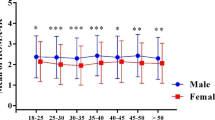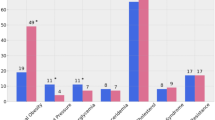Abstract
Purpose
To define reference values for various insulin sensitivity (IS) indices in healthy women in a population-based study of the five provinces in Iran
Methods
In this cross-sectional study, 250 normal-weighted women without hypertension, diabetes, polycystic ovary syndrome, hormonal disorders, pregnancy, or menopause were evaluated in this study. After a 12-h fasting, blood samples were obtained from all participants, levels of metabolic markers (fasting plasma glucose, lipid profile, insulin, etc.) were measured using enzymatic colorimetric and ultrasensitive enzyme-linked radioimmunoassay methods. Multiple insulin sensitivity indices were calculated using well-known predetermined formulas. K-means cluster analysis was used to determine reference values for each insulin sensitivity index.
Results
The threshold values of homeostasis model assessment (HOMA-%β, HOMA-βcell) and fasting insulin resistance index (FIRI) were 400.41, 198.55, and 2.57 corresponding to 97th, 93rd, and 92nd percentiles, respectively. Reference values of quantitative insulin sensitivity check index (QUICKI) and TG/HDL-c were 0.44 and 4.40, both of which relate to 92nd percentile. The recently introduced single-point insulin sensitivity estimator (SPISE) was analyzed and showed a threshold of 10.10 (87th percentile) in this study. Threshold values of reciprocal insulin (1/Insulin) and glucose-to-insulin ratio (G/I) were 0.51 (95th percentile) and 76.91 (99th percentile), respectively.
Conclusion
This study determined reference values for various insulin sensitivity indices in healthy Iranian women. These values can be used to define insulin sensitivity in women in epidemiological and clinical studies.

Similar content being viewed by others
References
Dankner R, Chetrit A, Shanik MH, Raz I, Roth J. Basal state hyperinsulinemia in healthy normoglycemic adults heralds dysglycemia after more than two decades of follow up. Diabetes Metab Res Rev. 2012;28(7):618–24.
Weyer C, Hanson RL, Tataranni PA, Bogardus C, Pratley RE. A high fasting plasma insulin concentration predicts type 2 diabetes independent of insulin resistance: evidence for a pathogenic role of relative hyperinsulinemia. Diabetes. 2000;49(12):2094–101.
Macut D, Bjekic-Macut J, Rahelic D, Doknic M. Insulin and the polycystic ovary syndrome. Diabetes Res Clin Pract. 2017;130:163–70.
Xun P, Wu Y, He Q, He K. Fasting insulin concentrations and incidence of hypertension, stroke, and coronary heart disease: a meta-analysis of prospective cohort studies. Am J Clin Nutr. 2013;98(6):1543–54.
Bergman RN, Ader M, Huecking K, Van Citters G. Accurate assessment of beta-cell function: the hyperbolic correction. Diabetes. 2002;51(Suppl 1):S212–20.
Ahren B, Pacini G. Importance of quantifying insulin secretion in relation to insulin sensitivity to accurately assess beta cell function in clinical studies. Eur J Endocrinol. 2004;150(2):97–104.
Singh B, Saxena A. Surrogate markers of insulin resistance: a review. World J Diabetes. 2010;1(2):36–47.
Radikova Z. Assessment of insulin sensitivity/resistance in epidemiological studies. Endocr Regul. 2003;37(3):189–94.
Paulmichl K, Hatunic M, Hojlund K, Jotic A, Krebs M, Mitrakou A, et al. Modification and validation of the triglyceride-to-HDL cholesterol ratio as a surrogate of insulin sensitivity in white juveniles and adults without diabetes mellitus: the single point insulin sensitivity estimator (SPISE). Clin Chem. 2016;62(9):1211–9.
Nakai Y, Nakaishi S, Kishimoto H, Seino Y, Nagasaka S, Sakai M, et al. The threshold value for insulin resistance on homeostasis model assessment of insulin sensitivity. Diabet Med. 2002;19(4):346–7.
Tohidi M, Ghasemi A, Hadaegh F, Derakhshan A, Chary A, Azizi F. Age- and sex-specific reference values for fasting serum insulin levels and insulin resistance/sensitivity indices in healthy Iranian adults: Tehran Lipid and Glucose Study. Clin Biochem. 2014;47(6):432–8.
Tehrani FR, Simbar M, Abedini M. Reproductive morbidity among Iranian women; issues often inappropriately addressed in health seeking behaviors. BMC Public Health. 2011;11:863.
Tehrani FR, Simbar M, Tohidi M, Hosseinpanah F, Azizi F. The prevalence of polycystic ovary syndrome in a community sample of Iranian population: Iranian PCOS prevalence study. Reprod bio and endocrin : RB&E. 2011;9:39.
Rashidi H, Ramezani Tehrani F, Bahri Khomami M, Tohidi M, Azizi F. To what extent does the use of the Rotterdam criteria affect the prevalence of polycystic ovary syndrome? A community-based study from the Southwest of Iran. Eur J Obstet Gynecol Reprod Biol. 2014;174:100–5.
Zawadski J, Dunaif A. Diagnostic criteria for polycystic ovary syndrome: towards a rational approach. In: Dunaif A, Givens J, Haseltine F, editors. Polycystic ovary syndrome. Boston: Blackwell Scientific Publications; 1992. p. 377–84.
Group. REA-SPCW. Revised 2003 consensus on diagnostic criteria and long-term health risks related to polycystic ovary syndrome (PCOS). Hum Reprod. 2004;19(1):41–7.
ESHRE TR, Group A-SPCW. Revised 2003 consensus on diagnostic criteria and long-term health risks related to polycystic ovary syndrome. Fertil Steril. 2004;81(1):19–25.
Muniyappa R, Lee S, Chen H, Quon MJ. Current approaches for assessing insulin sensitivity and resistance in vivo: advantages, limitations, and appropriate usage. Am J Physiol Endocrinol Metab. 2008;294(1):E15–26.
Quon MJ. Limitations of the fasting glucose to insulin ratio as an index of insulin sensitivity. J Clin Endocrinol Metab. 2001;86(10):4615–7.
Haffner SM, Miettinen H, Stern MP. The homeostasis model in the San Antonio heart study. Diabetes Care. 1997;20(7):1087–92.
Wallace TM, Levy JC, Matthews DR. Use and abuse of HOMA modeling. Diabetes Care. 2004;27(6):1487–95.
Ding C, Li T. editors. Adaptive dimension reduction using discriminant analysis and k-means clustering. Proceedings of the 24th international conference on Machine learning; 2007: ACM.
Zhang C, Xia S. editors. K-means clustering algorithm with improved initial center. Knowledge Discovery and Data Mining, 2009 WKDD 2009 Second International Workshop on; 2009: IEEE.
Wu L, Hoi SC, Jin R, Zhu J, Yu N. Learning Bregman distance functions for semi-supervised clustering. IEEE Trans Knowl Data Eng. 2012;24(3):478–91.
Sharma S, Sharma S. Applied multivariate techniques. 1996.
Tan P-N, Steinbach M, Kumar V. Data mining cluster analysis: basic concepts and algorithms. Introduction to data mining. 2013.
Esteghamati A, Ashraf H, Esteghamati AR, Meysamie A, Khalilzadeh O, Nakhjavani M, et al. Optimal threshold of homeostasis model assessment for insulin resistance in an Iranian population: the implication of metabolic syndrome to detect insulin resistance. Diabetes Res Clin Pract. 2009;84(3):279–87.
Moon S, Park JH, Jang EJ, Park YK, Yu JM, Park JS, et al. The cut-off values of surrogate measures for insulin sensitivity in a healthy population in Korea according to the Korean National Health and Nutrition Examination Survey (KNHANES) 2007-2010. J Korean Med Sci. 2018;33(29):e197.
McAuley KA, Williams SM, Mann JI, Walker RJ, Lewis-Barned NJ, Temple LA, et al. Diagnosing insulin resistance in the general population. Diabetes Care. 2001;24(3):460–4.
Sjaarda L, Lee S, Tfayli H, Bacha F, Bertolet M, Arslanian S. Measuring beta-cell function relative to insulin sensitivity in youth: does the hyperglycemic clamp suffice? Diabetes Care. 2013;36(6):1607–12.
Kim JK. Hyperinsulinemic-euglycemic clamp to assess insulin sensitivity in vivo. Methods in molecular biology (Clifton, NJ). 2009;560:221–38.
Acknowledgments
This original study was based on a thesis for fulfillment of a Master of Public Health (M.P.H.) degree at the School of Public Health, Shahid Beheshti University of Medical Sciences. The authors would like to thank the staff of the Research Institute for Endocrine Sciences and those who have worked in the Iranian PCOS Prevalence Study. Also, the authors are also grateful to the unlimited support of the staff of the School of Public Health, Shahid Beheshti University of Medical Sciences, Tehran, Iran.
Author information
Authors and Affiliations
Corresponding author
Ethics declarations
Conflict of interest
The authors declare that they have no conflict of interest.
Ethical consent
Informed written consents were obtained from all participants, and ethical review board of Research Institute for Endocrine Sciences approved the study protocol.
Additional information
Publisher’s note
Springer Nature remains neutral with regard to jurisdictional claims in published maps and institutional affiliations.
Rights and permissions
About this article
Cite this article
Tehrani, F.R., Hashemi, N., Montazeri, S.A. et al. Optimal reference values for insulin sensitivity indices in Iranian healthy females: a population-based study. Int J Diabetes Dev Ctries 40, 591–596 (2020). https://doi.org/10.1007/s13410-020-00814-7
Received:
Accepted:
Published:
Issue Date:
DOI: https://doi.org/10.1007/s13410-020-00814-7




